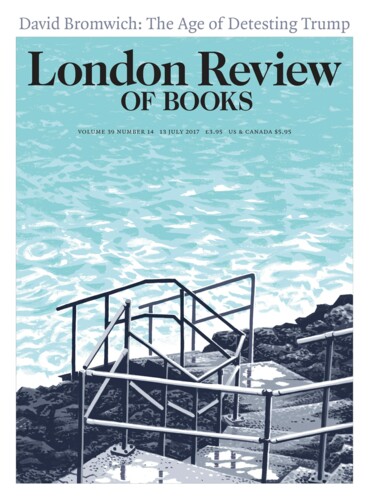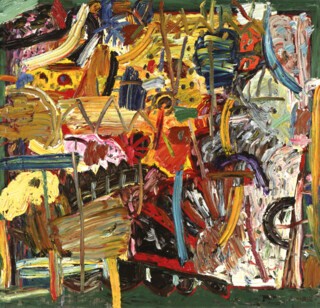The huge canvases Gillian Ayres painted during the 1980s rush at you like Atlantic breakers. Bursts of orange, viridian, scarlet, yellow and cyan tumble forward and engulf you; convulsions of oil paint are thrown up at such a pace they seem weightless. Handfuls are grabbed from paint pots and thrust every which way, urging the viewer to fall in with the flux.
The exhibition of Ayres’s work at the National Museum of Wales in Cardiff (until 3 September) foregrounds these extravaganzas, which date from Ayres’s six-year sojourn in the Llyn peninsula. Their unruliness exceeds definition. The nine and a half foot high Antony and Cleopatra seems luxurious – its square of yellow ochre is fringed with the zigzag borders of an Oriental carpet – but it abandons courtesy in favour of an escalating battle of colour, fought to a climax in its top left corner. With its internal arena Dance of the Ludi Magni might be a painting about painting, echoing Howard Hodgkin’s work. But where self-reflexiveness led Hodgkin into pathos, it exhilarates Ayres. Not haunted, as he was, by the ghosts of human figures, she reaches for her globs of paint as if to shout for shouting’s sake. The upwards tumbling torrent of A Belt of Straw and Ivy Buds swaggers with energy, until, at the top of the canvas, two closed-off compartments rebuff it: river reverting to rug.
In her years on the Llyn Ayres juggled the roles abstract painting might enact – a grand ornament, a meditation on artistic means, a melodrama of mobility – keeping all in the air. This legerdemain is especially on show in Æolus, a seven by seven foot canvas from 1987 with a zingingly fresh surface. In some of her canvases drawing is more or less avoided, as though out of suspicion: for Ayres’s colours to remain vivid and distinct, they must have boundaries, but she prefers a brusque four-finger swipe or a coarse brush’s perfunctory looping to any distinctive thought about shapes. In her more recent work, which isn’t on show at Cardiff, there is a recognition that shape might be a painter’s friend; that structure might flatter pigments rather than shackle them, and that if these units happen to suggest landscapes or plants, no real harm is done to the cause of abstraction. But in Æolus the impulse to cut space – which is what lines do – changes gear and accelerates, from carving out bands and formal entities to slashing at the whole chromatic tapestry. The painting defaces itself.
Abstraction has been Ayres’s cause ever since she quit Camberwell School of Art in 1950. Beyond Cardiff’s two rooms showing her 1980s work, further galleries follow her steps backwards. The exercise gets to feel archaeological. Artists in 1950s London were challenged both by Continental tachisme, with its blots and smears, and by Hans Namuth’s photographs of Jackson Pollock at work on his drip paintings. Ayres responded by laying great boards on the floor and splattering them with hardware shop enamel paints in black, sienna, flame red and prussian blue. The high spirits of this experimentation still bubble up through the yellowed primer and ruckled Ripolin of the early paintings but give little sense of the tensions that impelled it or where it meant to head, beyond the general hankering for the sublime that permeates the exhibition. Some of Ayres’s works of the early 1960s, however, started interpreting abstraction as a groping after origins, adapting the staining techniques then popular in the US. Protozoa – floating, globular possibilities – emerge as cupfuls of pigment, variously thinned, dropped onto the horizontal canvas to spread out and sometimes combine: a staging of innocence done with an artful hand. Ayres has always had a lovely way with her media.
The outstanding example of Ayres’s earlier work in these galleries is a vast untitled canvas, 24 feet long, on which thousands of dabs cluster irregularly. Monet’s pond paintings appealed to many painters in the 1960s: the spawn filling this analogue to them, being mostly purple, take us to some exotic, blissed out order of experience. This picture seems to have been kept rolled away in storage, along with others, ever since it was exhibited in 1971. Mel Gooding, in his monograph on Ayres, records the gallerist John Kasmin asking her: ‘What am I meant to do with them?’ ‘You’re a dealer: I’m a painter. I must get on with what I want to do.’
The tone of that is typical. One-foot-out-the-door-ness flavours the whole Ayres operation and has, despite Kasmin’s exasperation, contributed to its appeal and its viability. In the Cardiff selection, this dislocation is heightened by a few curios that seem to follow quite other modes of abstraction. You feel that, loosely at least, Ayres has tracked every trend in postwar abstraction, from the hard-edge style of Robyn Denny to Larry Poons’s encrusted canvases; you can even imagine Æolus as her response to 1980s graffiti art.
But the looseness is the point. Ayres told Gooding that the spectacular internal arguments into which she threw herself while living in the old rectory near Pwllheli took their point of departure from Hans Hofmann, father figure to the New York School. But they feel intentionally removed from any metropolis, including London, where her paintings were being sold. (Still less, for that matter, do they interact with the Wales of R.S. Thomas, stationed at another rectory a few miles down the road.) Sea, Sea the Shepherd’s Queen is one of Ayres’s whimsical titles: a misspelling of a Jacobean madrigal applied to a tumultuous wrestle of colour in which marine blues win out. The choice of words seems to indicate the attitude. ‘Arenas for freedom’ may have been the phrase ideologues liked to reach for in the heyday of British abstraction. But what they really meant was pastorals: glorious, gratuitous elsewheres.
Send Letters To:
The Editor
London Review of Books,
28 Little Russell Street
London, WC1A 2HN
letters@lrb.co.uk
Please include name, address, and a telephone number.


